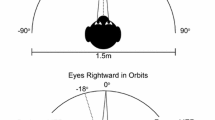Abstract.
The gaze control system governs distinct gaze behaviors, including visual fixation and gaze reorientations. Transitions between these gaze behaviors are frequent and smooth in healthy individuals. This study models these gaze-behavior transitions for different numbers of gaze degrees of freedom. Eye/head gaze behaviors have twice the number of degrees of freedom as eye-only gaze behaviors. Each gaze behavior is observable in the system dynamics and is correlated with neuronal behaviors in several, coordinated neural centers, including the vestibular nuclei. The coordination among the neural centers establishes a sensorimotor state which maintains each gaze behavior. This study develops a mathematical framework for synthesizing the coordination among neural centers in gaze sensorimotor states and focuses on the role of vestibular nuclei neurons in gaze sensorimotor state transitions.
Similar content being viewed by others
Author information
Authors and Affiliations
Additional information
Received: 17 December 1999 / Accepted in revised form: 3 May 2001
Rights and permissions
About this article
Cite this article
McCollum, G., Boyle, R. Conditional transitions in gaze dynamics: role of vestibular nuclei in eye-only and eye/head gaze behaviors. Biol Cybern 85, 423–436 (2001). https://doi.org/10.1007/s004220100270
Issue Date:
DOI: https://doi.org/10.1007/s004220100270




